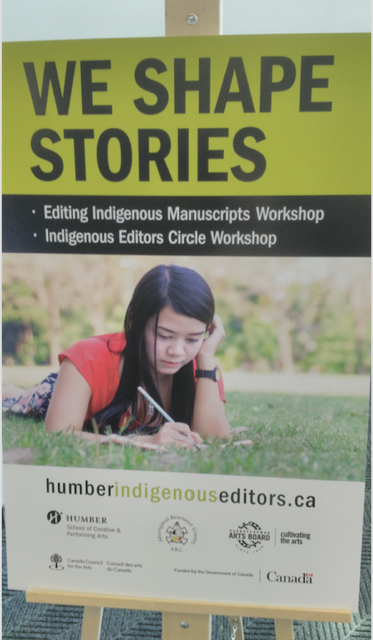
A Quill and Quire article popped up in my Twitter feed in late June: “Humber becomes new home for Indigenous Editors Circle.” I was thrilled that the Circle had found a home at Humber College’s Lakeshore campus in Toronto’s west end. Even better: a workshop on editing Indigenous manuscripts was being held in mid-August. I signed up right away.
Besides Cherie Dimaline (opening keynote speaker at the 2017 Editors Canada conference), the faculty included Greg Younging, publisher of Theytus Books; poet Gregory Scofield; and Warren Cariou, Canada Research Chair in Indigenous Studies at the University of Manitoba. They and other speakers would share their wisdom with 34 non-Indigenous and nine Indigenous participants. But how much could I learn about this complex topic in such a short time?
As it turned out, lots. Listening to countless stories (funny, heartfelt, tragic, hopeful) from the worlds of writing, editing and publishing, I sensed the shift that is happening: Indigenous stories are making their way into the wider narrative, and editors need to know how to approach them.

Editing is a skill and an art. The technical side is important, but above all, an editor needs to be able to listen. Listen to the words, to the storyteller. Listen to the stories that echo down through communities. Sit with those living stories. Carry them with you. Spend time with those voices. Learn about those communities.
The word “respect” came up often. Respect these stories that have existed for longer than we know.
Appreciate the culture that gave birth to them. Honour the truth, the joy, the pain heard in that voice. Recognize the wisdom in people who have handed down stories for many thousands of years.
While much of the learning was of the heart — how to be present to the author and their story; how to let go of one’s biases and usual ways of approaching texts; how to “see through Indigenous eyes” — some concrete approaches for editors also emerged:
- encourage Indigenous people to work as editors (and in other roles in publishing) so their voices are included, and provide training and mentoring
- read works by Indigenous authors
- take part in Indigenous events
- be aware of which stories (e.g. traditional, ceremonial, sacred) involve protocols
- make sure authors have done their research and have permission from elders to tell the story
- work closely with the author and get to know them — relationships are key (having tea and pie together was recommended)
- retain words in Indigenous languages (explain them through context), and preserve the author’s style rather than trying to make it easy for the reader
- ask the publisher to leave copyright with the author or community if this is not standard practice
- attend workshops on editing Indigenous manuscripts to learn and to connect with other editors
At one of the daily closing Circles, participants spoke of how the sessions had touched them, of being transformed and grateful. Yes. Thank you. Miigwetch. As Indigenous and non-Indigenous editors, authors, colleagues and friends, let’s keep talking and sharing stories.
What’s your perspective? If you’re a non-Indigenous editor, how do you approach manuscripts by Indigenous authors? If you’re an Indigenous writer or editor, do you have any advice?
~~~
The Editors’ Weekly is the official blog of Editors Canada. Contact us.
Discover more from The Editors' Weekly
Subscribe to get the latest posts sent to your email.
